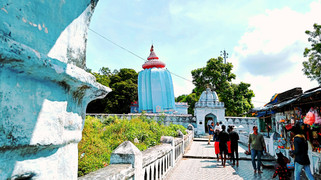Odisha : Beyond the Golden Triangle - Exploring Unsung Treasures
- ashokkdas1958
- Oct 11, 2024
- 8 min read
Odisha : Beyond the Golden Triangle - PART – I : Huma Temple, Patali Srikhetra, Ranipur-Jharial, Charishambhu Temple & Sahasra Shivalinga Cave Temple
Odisha, “India’s best kept secret”, is a state brimming with history, culture, and natural beauty. While the famed Golden Triangle: Puri, Konark, and Bhubaneswar, undoubtedly deserve their acclaim, they merely scratch the surface of what this enchanting state offers. Just drive beyond the well-trodden path and you will be amazed to explore a plethora of lesser-known treasures waiting to be discovered. It's time to venture off the beaten track and explore the hidden gems of Odisha. The state promises an unforgettable journey for those seeking authentic experiences and a deeper connection with India's rich heritage.
With that backdrop let me present few such hidden gems which I came across driving through the western and southern part of the beautiful state of Odisha, truly the “India’s best kept secret”.
A. The Leaning Wonder of Odisha: Huma Temple
While taking about leaning monuments, the first name comes to mind is the Leaning Tower of Pisa, Italy. But located on the bank of Mahanadi River about 25 kilometers from Sambalpur is the enigmatic Huma Temple, often referred to as the Leaning Temple of India. This unique temple complex has captivated the minds of historians, archaeologists and tourists alike and its architectural marvels often defy logic.
The Enigma of the Tilt
Built in the 16th century by Raja Baliyar Singh of Sambalpur, the temple is dedicated to Lord Shiva. Its peculiar tilt, which is almost 47 degrees, adds to its allure. While the main temple is dedicated to Lord Shiva worshiped as Lord Bimaleswara, other smaller temples in the complex are abodes for other Gods and Goddesses. Unlike its more famous Italian counterpart, the Leaning Tower of Pisa, the reasons behind Huma Temple's inclination remain shrouded in mystery. More surprisingly, while the main temple is tilted in one direction, the other smaller temples in the complex are tilted in other direction. As per the locals and the priests, the angle of tilt has not changed since last 60-70 years.
The majestic Mahanadi
As you approach the temple, its tilted silhouette against the backdrop of the serene Mahanadi River creates a striking image. The temple's architecture, though simple, is elegant, and the surrounding greenery and the majestic Mahanadi River adds to its charm. You can spend leisurely hours by the river, watching the colorful fish or simply seat peacefully in the tranquil surroundings.
B. Patali Srikhetra: A secret legacy of Lord Jagannath away from Puri
Lord Jagannath is the soul of Odisha as its identity is deeply intertwined with the worship, tradition and culture surrounding the Lord. The Sri Mandira at Puri is the holy abode of Lord Jagannath along with his elder brother Lord Balavadra and younger sister Devi Subhadra. While people world over know about the Lord Jagannath and Jagannath Temple and the holy Rath Yatra, most are unaware that the divine trio of Lord Jagannath, Balabhadra, and Devi Subhadra were out of their abode at Puri for 144 years, the longest ever period when they were out of Puri.
A Tale of Exile and Rediscovery
As described in the Madalapanji, the chronicle of the Jagannath Temple, to protect the idols of Lord Jagannath, Balabhadra, and Devi Subhadra from islamic invaders King Sovanadeva took the idols out of Puri. The idols were shifted and buried in the cave of Trikuta Hill near Subarnapur. The divine trio remained concealed within the heart of the hill for a period of 144 years. It was later rediscovered by efforts of King Jajati Keshari of the Somavamsi dynasty. New images were crafted and installed in the Puri temple, while the original site continued to be revered as a sacred pilgrimage destination.
Natural Beauty
Nestled amidst the serene landscapes of Trikuta Hills near Kot Samalai village of Subarnapur district, Patali Srikhetra stands as a testament to the rich history and spiritual significance of the region. The serene atmosphere, coupled with the breathtaking natural beauty of the Trikut Hills, create a perfect setting for spiritual introspection. This majestic hill is the heart of the site. The caves, where the idols were once hidden, are a major attraction. Even today, there's an undeniable spiritual energy that permeates the atmosphere. The stiff climb on the rugged hilly terrain though strenuous gives the exciting trekking and hiking experience. From the hilltop, you will be just stunned by the breathtaking views of the surrounding valley.
C. Charishambhu Temple: A Twin Temple Marvel near Boudh
Moving down the serene banks of the Mahanadi River, lies the quaint Gandharadi village of Boudh district where there is a unique architectural marvel - the 9th Century Charishambhu Temple, one of the oldest temple in the whole of Odisha state. Often referred to as the Gandharadi Temple, this sacred site is a testament to the rich cultural and religious heritage of Odisha.
Spiritual Significance
What sets Charishambhu Temple apart is its distinctive feature; it houses two distinct temples dedicated to different deities on a high rising stone platform within the same complex. The left shrine is dedicated to Lord Vishnu, revered as Lord Nilamadhava, while the right one is consecrated to Lord Shiva, worshipped as Lord Siddheswar. This harmonious coexistence of Vaishnavism and Shaivism under one roof is a rare sight, making it a pilgrimage site for devotees of both sects.
Architectural Brilliance
The temples, constructed in the 9th century AD under the patronage of the Bhanja rulers, showcase exquisite craftsmanship, though desecration and vandalism coupled with lack of proper maintenance time has taken its toll on these splendid architectural marvels. Although the temples appear similar initially, their distinct crowns, a linga atop Siddheswar Temple and a chakra on Nilamadhava Temple, set them apart and are easily noticeable from afar. The black granite idol of Lord Nilamadhava is extremely beautiful and is feast for the eyes.
Travel tips :
Best Time to Visit : For a serene and peaceful experience, the ideal time to explore these three enchanting destinations is during the winter months (October to February). The pleasant weather makes for a comfortable journey. While accessible throughout the year, the harsh summer heat is best avoided. Additionally, it's advisable to skip Patali Shrikhetra during the rainy season due to hazardous climbing conditions.
How to Reach : To reach these captivating sites, hiring transportation from nearby towns is recommended unless you have your own vehicle. Subarnapur, the district headquarters, offers the closest proximity to Patali Shrikhetra, with Charishambhu Temple on one side and Huma Temple on the other. However, limited accommodation options and lack of rail connectivity might pose some inconvenience. Sambalpur and Bolangir, both well-connected by rail, provide better accommodation choices. These three destinations can be comfortably covered in a single day. To tackle the challenging climb at Patali Shrikhetra, it's recommended to visit this site first thing in the morning.
D. Ranipur-Jharial: A Hidden Gem of Ancient Odisha
Moving away from the scenic bank of River Mahanadi and further in to the western Odisha, you will reach at a remote non-descript village in Bolangir District, the Ranipur-Jharial, where you will come across a large spread of ancient but most forgotten temple complexes thankfully surviving against the time.
64 Yogini Temple Somnath Temple Indralath Temple
Seated on a barren hilltop near Ranipur-Jharial is the captivating ancient 9th century Chausathi Yogini Temple, a captivating archaeological site boasting a collection of ancient temples. The hypaethral complex offers a unique open-air experience. The centerpiece is a circular Yogini temple, showcasing larger-than-life yogini figures carved from laterite. Many of these idols bear animal heads and even hold human corpses, suggesting a connection to Tantric rituals. Despite the ravages of time, the 62 surviving yoginis and the central Nateshwar Shiva shrine create a powerful atmosphere. Nearby, another 9th-century temple dedicated to Lord Shiva as Somnath stands as a testament to the site's religious significance. Further on, the 10th-century Indralath temple, the tallest brick temple in Odisha, exhibits a fascinating blend of Shaivite, Vaishnavite, and even Buddhist influences. The presence of multiple ancient temples on this remote hilltop indicates its importance as a religious center. However, due to its isolated location and lack of infrastructure, this hidden gem remains largely unexplored by tourists.
For more details about this enchanting and exclusive destination, please go through my earlier post : Unveiling the Mystery : A Pilgrimage through Yogini Temples across India https://www.ghumnechalo.in/post/unveiling-the-mystery-a-pilgrimage-through-yogini-temples-across-india
E. Sahasra Shivalinga Cave Temple :
A Mystical Marvel in rugged terrain of Koraput
Now let us move south-ward and explore another interesting and miraculous site deep inside the hilly terrains of Koraput in South Odisha, the enigmatic Sahasra Shivalinga Cave Temple. On a small hillock amidst the lush greenery and rugged terrains of the remote tribal village Kutnipadar under Laxmipur Block of Koraput District lies this truly awesome marvel.
A Tapestry of History and Legend
The exact origins of this Temple are shrouded in mystery. Local folklore tales of divine intervention, with the Shivalingas believed to have formed naturally over centuries. The temple's name itself translates to 'Thousand Lingams', a fitting description for the countless Shivalingas that adorn the site. While concrete historical evidence is lacking, the temple's existence can be traced back to ancient times. Going by the local tribal inhabitants who are worshiping there, this cave temple is in existence from many generations.
A Spiritual Sanctuary
The temple complex is a marvel in itself. The natural formation of the Shivalingas, interspersed with small caves and rock formations, is a sight to behold. As you wander through the temple, you'll discover Shivalingas of various sizes and shapes, each with its own unique charm. While the main attraction is undoubtedly the countless Shivalingas, the temple complex also houses idols of some other deities that add to the overall spiritual significance of the place. The daily rituals and worshiping is being carried out by the tribal priests. The temple's location, surrounded by hills and forests, enhances the spiritual experience. This extraordinary place of worship is a testament to nature's artistry and human devotion, captivating the hearts of all who venture there.
Travel tips :
Best Time to Visit : The Sahasra Shivalinga Temple is accessible year-round, but the most pleasant experience is between September and April. This post-monsoon and winter period blankets the region in lush greenery, creating an idyllic backdrop for exploring the surrounding area.
How to Reach : Reaching the Sahasra Shivalinga Temple is an adventure in itself, but the reward is unparalleled. The nearest towns, Koraput and Laxmipur, serve as starting points. While both offer transportation options, Koraput is generally preferred for accommodation. Limited rail connectivity exists to both towns
Conclusions :
Traditionally, the Golden Triangle of Puri, Konark and Bhubaneswar undeniably overshadow other tourist destinations in Odisha. This is primarily due to a combination of factors like Historical and Cultural Significance, Accessibility and Infrastructure, Marketing and Promotion lopsided and to a large extant apathy and regional disparity. As result while the Golden Triangle not only attracts a major portion of tourists and in the process have overloaded and overcrowded these destinations, a plethora of other captivating destinations have remained unexplored, neglected and out of bound to tourists. To my utter dismay whenever we have visited these marvelous tourist attractions, we were the only visitors at all three places except Huma Temple. Surprisingly most of the people even of the nearby districts are not much aware of these destinations.
It is high time the authorities should make concerted efforts to (a) Diversify Tourism Products, (b) Develop Regional Circuits, (c) Improve Infrastructure and for (d) Targeted Marketing with Community Involvement to achieve a more balanced tourism development, benefiting the entire state and preserving its rich cultural heritage.
Do stay with me in my exploration across Odisha, beyond the Golden Triangle.
Related reading :
Unveiling the Mystery : A Pilgrimage through Yogini Temples across India https://www.ghumnechalo.in/post/unveiling-the-mystery-a-pilgrimage-through-yogini-temples-across-india
Other posts by the author :
Beyond Pangong Tso and Tso Moriri: Unveiling Ladakh's Hidden Gems https://www.ghumnechalo.in/post/beyond-pangong-tso-and-tso-moriri-unveiling-ladakh-s-hidden-gems
Hidden Gems of the Himalayas: High Passes in Ladakh Overshadowed by Giants https://www.ghumnechalo.in/post/high-mountain-passes-in-ladakh
Unveiling the Untamed Beauty: An offbeat travel guide to exploring the hidden villages of Ladakh https://www.ghumnechalo.in/post/ladakh-hidden-villages-offbeat-travel
Ladakh's Silent Sentinels: A Journey through War Memorials https://www.ghumnechalo.in/post/ladakh-s-silent-sentinels-a-journey-through-war-memorials
Unveiling the Spiritual Gems of Ladakh: A Journey through Monasteries https://www.ghumnechalo.in/post/unveiling-the-spiritual-gems-of-ladakh-a-journey-through-monasteries
Unveiling Tranquility : A Journey through Ladakh's Buddha Statues https://www.ghumnechalo.in/post/unveiling-tranquility-a-journey-through-ladakh-s-buddha-statues









































































Comments